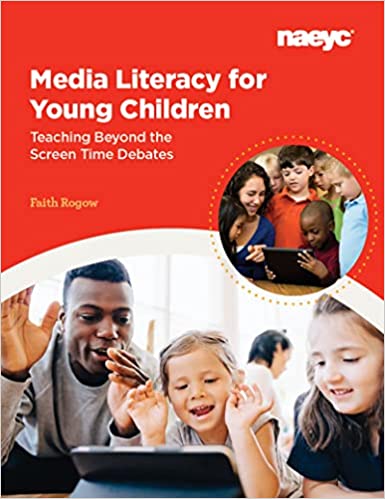Early Childhood Resources Review
Media Literacy for Young Children
Science and Children—July/August 2022 (Volume 59, Issue 6)
By Laura Weilert

Media Literacy for Young Children: Teaching Beyond the Screen Time Debates
by Faith Rogow. 2022
The National Association for the Education of Young Children. 176 Pages $30
In Media Literacy for Young Children: Teaching Beyond the Screen Time Debates, author Faith Rogow does not get pulled into the fray around media. Instead, the author presents thorough explanations and examples to empower teachers of young students to think critically about the various media targeted toward children. The youngest children face a collaborative digital world that adults can only imagine. How do we teach kids to be wise consumers of a future we cannot predict? How do we harness digital tools as tools for creativity and collaboration?
In Part I, Rogow uses many examples to frame the context of early learners and to bring educators up to speed as the media world burgeons. Biases, stereotyping, and desensitization take hold, she argues, when children don’t analyze ever-present media with the help of teachers attuned to media literacy education. The author deals with the alarming context of our society regarding media for young children. She does so by empowering educators throughout the book with tactical examples and professional reflection exercises.
Recognizing that many adults respond to technology with fear, the author offers low-tech examples of exercises tied to media literacy. Showing children pictures that provoke emotions is using media. Talking with young children about how advertisers use these pictures to market products helps children become wiser consumers of media. Asking the question, “Is there really fruit in Froot Loops?” provides the opportunity to invite children to engage in research and to develop the scientific disposition of questioning.
The formatting of text, examples, reflections, and overall organization speaks a clear story of a difficult topic. The tie-in to practice includes examples of young children creating media as they create a cereal box that is responsibly marketed, write songs to share, and create memes. Some activities are designed as individual stand-alone activities while others might span many weeks if children are engaged.
Part II focuses on core competencies in media literacy education. The primary goal is to move children to start asking important questions about the who, what, and why. Rogow notes the difference of media consumer versus media maker in highlighting how young children should engage with media in and out of the classroom.
While Part II offers consistent ideas for practice, Part III addresses the challenges. What can we change? Many sectors benefit from the limited protection from consumption-based content in media targeting children, but the author supports a great counter argument which is to instead make children the creators of intentional media.
Knowledgeable guidance from an informed teacher is crucial and is not widespread in the early childhood community. Here emerges the need for this book. Parents are invited into creating media-literate children with clear explanations in this final section of the book. The research-based evidence of literacy over screen-time debates completes the book. Rogow also asks what is media, who are we, and why are we engaging? Asking and answering the questions posed in this text are excellent steps toward becoming a media literacy educator. ●
Laura Weilert (laura@thatsciencefairy.com) is a graduate in Molecular Biology (University of Colorado) who often found herself educating. Since 2016 she propels STEM through experiences with real materials as That Science Fairy, a mobile STEM preschool teacher in Colorado Springs, Colorado.
Instructional Materials Literacy Early Childhood


